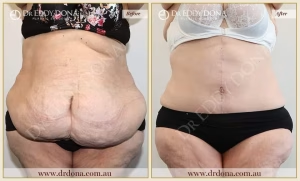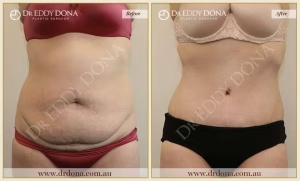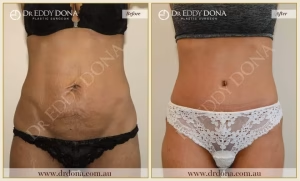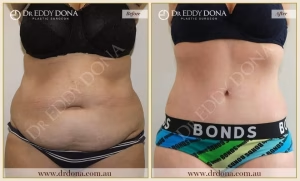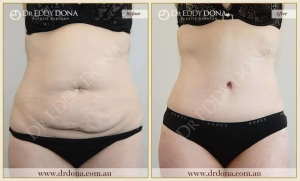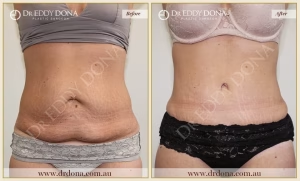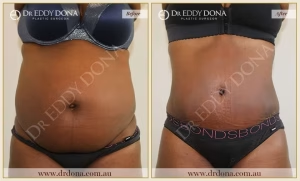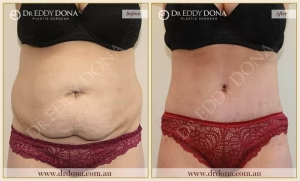Tummy Tuck (Abdominoplasty)
As a meticulous practitioner, Dr Dona consistently refines his surgical skills, maintaining a steadfast commitment to delivering excellence in Plastic Surgery.
Book a Consultation With Dr Dona or Request a Callback

Tummy Tuck (Abdominoplasty)
BEFORE & AFTER GALLERY
The displayed before and after pictures are provided as an educational tool to demonstrate some of the results achievable from plastic surgery. Results may vary due to many factors including an individual’s genetics and lifestyle. All surgery carries risks and requires recovery time.
Tummy Tuck (Abdominoplasty) SYDNEY
Tummy Tuck, also referred to as Abdominoplasty, is a surgery performed to address concerns that relate to the belly following trauma, pregnancy and/or weight loss. The most common concerns are stretch marks (scars caused by skin that has been forced to stretch too much too quickly), excess skin, excess fatty tissue and weakened separated muscles. Other problems can include hernias involving the belly button and significant abdominal wall muscle separation that can affect posture and result in lower back pain. In addition, individuals can express concerns regarding their pubic area which includes fullness and ptosis (droop). This typically causes difficulties with tight fitting clothing and hygiene problems.
These concerns can be addressed with a well-planned Tummy Tuck (Abdominoplasty). The excess skin can be removed including most, if not all, of the lower abdominal wall stretch marks. Doing this means removing many of the stretch mark scars that you can’t hide, and creating a single scar below your bikiki line that can be comfortably hidden. If required (and it usually is), the pubic area is thinned out and lifted.
Also, any muscle separation (along with any hernias) is also repaired. This is a vital part of most Tummy Tucks and provides significant functional benefits. Ultimately the purpose of a Tummy Tuck (Abdominoplasty) is to primarily change function (medical/lifestyle issues) and secondarily change form (appearance).
BOOK A CONSULTATION

Call 1300 373 662
- OR -
FREQUENTLY ASKED
QUESTIONS
Learn More About Tummy Tuck SurgeryIf you’ve booked a consultation to visit and discuss Tummy Tuck (Abdominoplasty) Surgery, then there’s a few things to know about what happens on that day.
Firstly, upon arriving at our Sydney clinic you will be met by our friendly team, and they will walk you through the initial patient registration process. Once this is done, you will be ready to be taken through for your initial consultation with Dr Dona.
During this consultation, you will asked a number of questions, including about your relevant medical background, history of surgery, especially abdominal surgery, and your general tummy concerns.
Dr Dona will then carry out a physical assessment and assess your belly and all concerns you have with it, including skin, fat and muscle issues.
Once you are assessed, and if you are considered suitable for surgery, then a surgical plan is created to suit your goals. Of course, an important part of this process is ensuring you have a realistic expectation about the results achievable.
Dr Dona will then discuss the details of the surgery, your expected recovery period and inform you about the potential risks and complications that allow you to make an informed decision.
During this entire process you will be able to ask any questions you have related to your considered surgery. Fortunately, all of our patients are required to watch a number of explanatory videos prior to their first consultation to make the entire process as productive as possible.
Photos are then taken for our medical records.
Finally, you will then discuss with one of our friendly team members, the costs and any logistics regarding possible surgery dates.
The term Abdominoplasty (Tummy Tuck) is really a simple term that encompasses any operation that reconstructs the abdominal wall. This is because the degree of problems one has will dictate the type of abdominoplasty that is necessary.
The different names applied to the different Tummy Tucks typically relates to the surgical scars created. Common names include:
- MINI-TUMMY TUCK (ABDOMINOPLASTY)
- STANDARD TUMMY TUCK (ABDOMINOPLASTY)
- FLEUR-DE-LIS TUMMY TUCK (ABDOMINOPLASTY)
- OPEN BOOK TUMMY TUCK™ (ABDOMINOPLASTY)
- REVERSE TUMMY TUCK(Abdominoplasty) – the scar pattern is isolated to the upper abdominal wall and lower chest region and lifts the abdominal wall skin. The scar does not extend to the back and is essentially the front half of a BRA LIPECTOMY (upper body lift).
- BELT LIPECTOMY combines two operations: a Buttock Lift and a Tummy Tuck (Abdominoplasty), which results in one continuous circumferential scar contained within the belt line.
Many variations exist within each type and the above is a very simplistic breakdown.
One of the common problems associated with pregnancy is separation of the abdominal six pack muscles, officially known as Diastases Recti.
This can vary from mild to extreme.
This causes a few issues.
- Firstly, it results in a greater abdominal girth than is necessary, which basically means your belly is bigger than it needs to be.
- In extreme cases it can act very much like a hernia, so when you strain a large ridge like fullness protrudes along your abdominal wall midline.
- With significant separation, it can potentially result in a disturbed biomechanical performance of your entire lower back and midsection. So basically, your core strength is not as great as it should be, you get increased arching of your lower back and the resultant back pain.
- These muscle issues can potentially have an impact on bladder control.
Ultimately, a routine part of most Tummy Tucks is tightening of these separated muscles to help re-align the muscles, tighten your waistline and improve your core strength.
Occasionally, in some women who have great skin quality and tone but significant muscle separation, you could have a minimal access surgery designed to just repair your muscles. This is done via a lower abdominal incision similar to a caesarean scar with or without an additional small belly button incision.
Abdominal wall hernias are relatively common, and many people wanting a Tummy Tuck (Abdominoplasty) that also have hernias ask if the hernia can be repaired at the same time.
The first thing to appreciate is that the muscle separation is very common especially after pregnancy and is in many ways a type of hernia. It is an area of weakness along the midline and in some people, it can protrude ridge like down the midline when they strain.
Repairing this involves tightening up and re-aligning the muscles to close this weakness.
The day before surgery, the Sydney hospital will call and advise you when you need to arrive at the hospital and the pre-surgical requirements such as when to begin fasting prior to your surgery. Upon arrival at the allocated hospital, you will be required to check in with the reception staff. You will then be seen by a hospital staff member who will direct you to the pre-surgical waiting area where you are officially “checked in” for your surgery. At this point you will be made comfortable while you wait to be taken into the operating room. We do our best to ensure that you are advised to come to the hospital as close to the scheduled surgery time, however sometimes you may have to wait a little longer than planned before we can start your surgery.
Prior to your surgery, you will be taken into the theatre anaesthetic bay. This is where Dr Dona will again go over the surgery and to remind you about what to expect when you wake up. Dr Dona will also make tentative surgical markings on you. In other words, he will draw his surgical plan on you and discuss this.
The Anaesthetist will also talk to you about the anaesthetic and the medications they’ll be giving you after surgery to keep you as comfortable as possible.
Finally, you get taken into the actual operating room.
Following your surgery, and once you have been discharged from hospital, you will attend our practice for your first post-operative review with one our post-operative nurses. Generally speaking, your first appointment will be scheduled no later than the day following your hospital discharge.
All of your post-operative appointments are organised and provided to you prior to your day of surgery. Have have standard follow-up appointments for the first 12 months.
Within your first post-operative appointment, one of our friendly and caring post-operative nurses will inspect your wounds and administer light therapy treatment, aimed at optimising your recovery.
Our post-operative nurses will continue to see you, at least three times per week for the following few weeks, and of course, will be available to answer any questions, in-between your in-clinic appointments.
We keep a careful eye on you and ensure you are hitting the correct recovery milestones during the crucial early post-operative period. We ultimately do all that we can to achieve an optimal outcome and that you are comforted and reassured during this phase.
More information on general potential complications can be found on our site. LEARN MORE
Whenever someone is having an anaesthetic, no matter what it’s for, then things can potentially go wrong. That is why no surgery should be considered “minor”. Of course, whilst the chances of the following potential problems occurring are extremely small, you still need to know about then:
- Anaesthetic issues – which can affect heart, lungs or cause strokes
- Allergic reactions – This can be very mild to life threatening.
- Clots
- Superficial vein clots, which is a complication of the cannula or drip that’s placed in your vein
- Deep vein clots – these can potentially spread to the lung and be life threatening. We do several things during surgery and after surgery whilst you’re in hospital to minimise the risk of you developing these.
- Wound problems – such as infection and breakdown
- Bleeding – early or late
- Death – whilst the chances of this is exceeding rare, any of the previous issues can result in this devastating complication.
All these potential problems are standard for any operation, although some operations and some patients have an increased risk of developing them.
